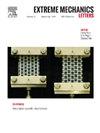Tracing back transient information from near-stationary random data
IF 4.5
3区 工程技术
Q2 MATERIALS SCIENCE, MULTIDISCIPLINARY
引用次数: 0
Abstract
Tracing back the past and predicting the future are of equal importance, while compared to the prediction, the backtracking is far from receiving the attention it deserves. With the explosive advances of the diffusion models, backtracking has undergone a complete renaissance, especially for stochastic systems. This work addresses this issue, tracing back transient information from near-stationary random data. Different from the diffusion models, we aim for statistical information but not sample information, and we only need near-stationary sample segments for identification, but not a large number of full-time samples for learning. The core idea of this data-driven method is: embedding Fokker-Planck equation (as a priori physical knowledge), which portrays the evolution of probability density of state, and then identifying and solving it to trace back the transient probability density. The efficacy of this method is demonstrated by three typical examples, namely, a one-dimensional linear system, a two-dimensional linear system, and the van der Pol system.
从近平稳随机数据追溯瞬态信息
回顾过去和预测未来同样重要,但与预测相比,回溯远远没有得到应有的重视。随着扩散模型的爆炸式发展,回溯已经经历了一个完整的复兴,特别是对于随机系统。这项工作解决了这个问题,从接近平稳的随机数据中追溯瞬态信息。与扩散模型不同的是,我们的目标是统计信息而不是样本信息,我们只需要近平稳的样本段进行识别,而不需要大量的全职样本进行学习。这种数据驱动方法的核心思想是:嵌入描述状态概率密度演变的Fokker-Planck方程(作为先验的物理知识),然后对其进行识别和求解,追溯瞬时概率密度。通过一维线性系统、二维线性系统和van der Pol系统三个典型实例证明了该方法的有效性。
本文章由计算机程序翻译,如有差异,请以英文原文为准。
求助全文
约1分钟内获得全文
求助全文
来源期刊

Extreme Mechanics Letters
Engineering-Mechanics of Materials
CiteScore
9.20
自引率
4.30%
发文量
179
审稿时长
45 days
期刊介绍:
Extreme Mechanics Letters (EML) enables rapid communication of research that highlights the role of mechanics in multi-disciplinary areas across materials science, physics, chemistry, biology, medicine and engineering. Emphasis is on the impact, depth and originality of new concepts, methods and observations at the forefront of applied sciences.
 求助内容:
求助内容: 应助结果提醒方式:
应助结果提醒方式:


